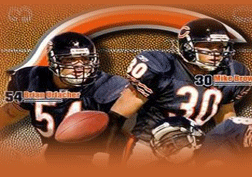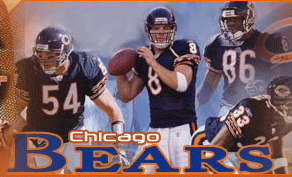|
The Chicago Bears in the season of their inception in 1920
wore blue jerseys with tan colored vertical striping. The
vertical stripes were stripes of leather that were neatly
stitched onto the uniform. The uniform gave a primitive look.
Since brown leather helmets offered little protection, many
players refused to wear them. The pants were made of brown
canvas and jerseys are made of wool. The prime color of the
jersey was orange with navy blue stripes. The strips of metal
embedded onto front of the jerseys helped the players hold onto
the football, which was fatter and harder to handle than the
modern version. In the 1930s, the numbers instead of back
appeared in the front and were more rounded. The primary color
of the jersey remained same but this time with black arm stripes
and black helmet. Till 1958 the Bears wore navy blue with burnt
orange. The jersey was so "loud" that the
New York
literally booed the jersey whenever the Bears came on the field.
In 1936, the team wore a dark helmet with three orange stripes
from front to back, a white jersey with 14 navy and orange
alternating stripes on the sleeves and shoulders. The socks had
alternate navy and orange stripes pulled from the ankle to the
knee. In the decade of 1940s the Bears returned to their basic
pattern of uniform. Except for some preseason games, the Bears
did not wear orange jersey. In the first half the team wore a
black jersey with orange numerals. Striping was added on the
pant. By 1949, the team introduced unique uniform number font
style which they followed for next half-century. In the 1950s
only minor modifications were made in the size and shape of the
jersey numbers.
With the turn of decade, the Bears trademark 'C' logo
appeared on helmets. This trend has been followed till today
while the mark has been changed from white to orange with a
slight change in the shape. In 1964, after running back Willie
Galimore and receiver John Farrington were killed in an
accident, the team wore a black armband on the left jersey
sleeve for the season to pay the tribute to these two players.
In 1969, the Bears celebrated their golden jubilee. For the
season, the team wore a commemorative patch on the left shoulder
for the season. In 1970, the names of the players appeared on to
the back of the jersey. Three years later the white 'C' logo was
colored orange with white border. In the 1970s the team also
experimented with stripes and color of fonts but after a couple
of seasons returned to its old form. In 1983, the team’s owner
George Halas died of cancer in
Chicago at age
88. The Bears to honor him, on their jersey wore a commemorative
plaque with initials "GSH" written on a football background. The
following season, the monogram was moved to the left jersey
sleeve. In 1984, a new uniform for “road games” with navy pants
and white jersey was introduced.
In 1994, the Bears celebrated their 75th
anniversary by wear the "throwbacks" uniforms in three games.
They adorned the 1920s look with orange vertical stripes on navy
jerseys, and tan pants. In 1999, after the death of Walter
Payton, the Bears wore a memorial patch with his uniform # 34 on
their jersey. In 2001, the team celebrated there three decades
of playing at Soldier Field. During that season "Salute to
Soldier Field" patch became the distinctive feature of the home
jersey. On
Oct. 7, 2002 on a Monday Night Football game against Green, the players
wore navy blue jerseys with navy pants for the first time. After
the death of team’s Chairman Emeritus Edward W. McCaskey in
2003, the players’ helmets featured "EWM" sticker in navy on an
orange shamrock. For a Thanksgiving Day game in 2004, the Bears
wore orange jersey with navy numbers trimmed in white with the
all-white "C" helmet decal.
|





